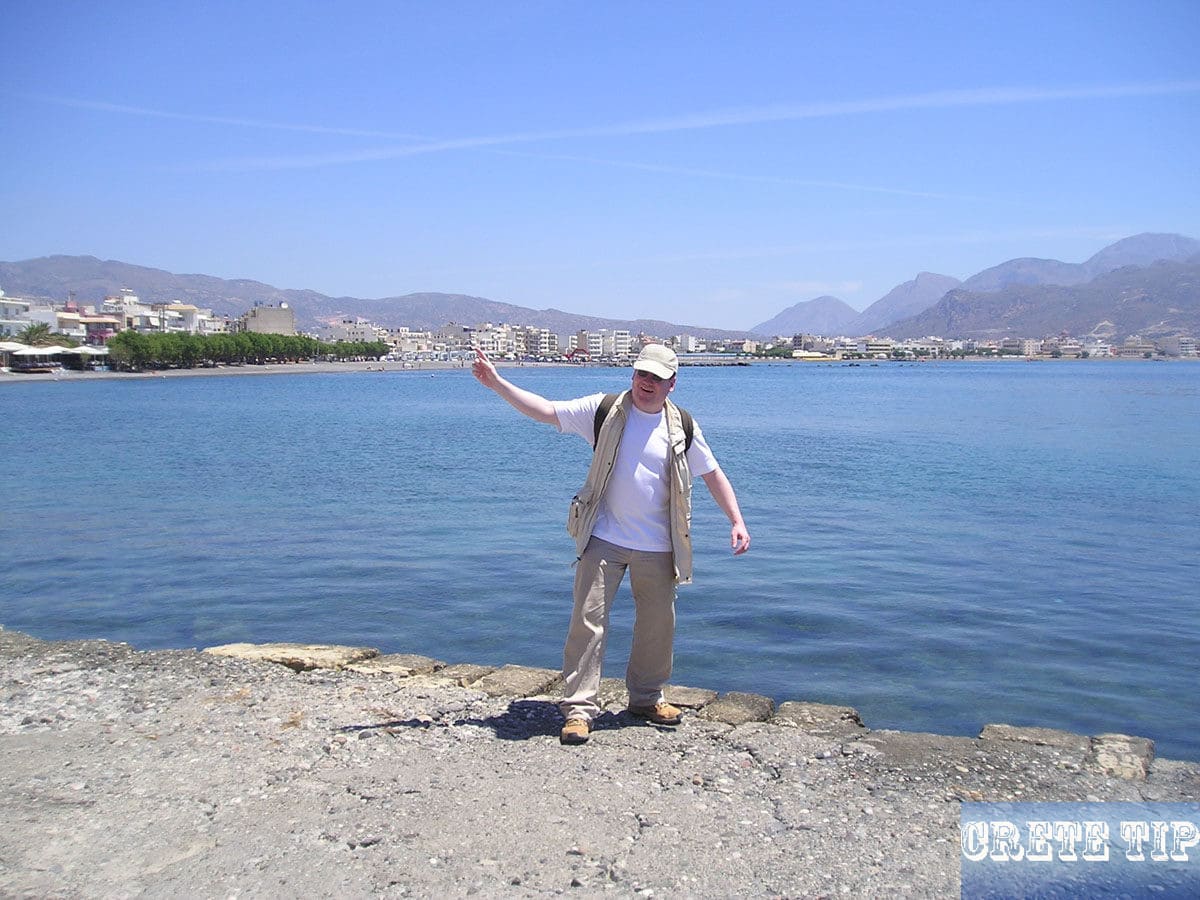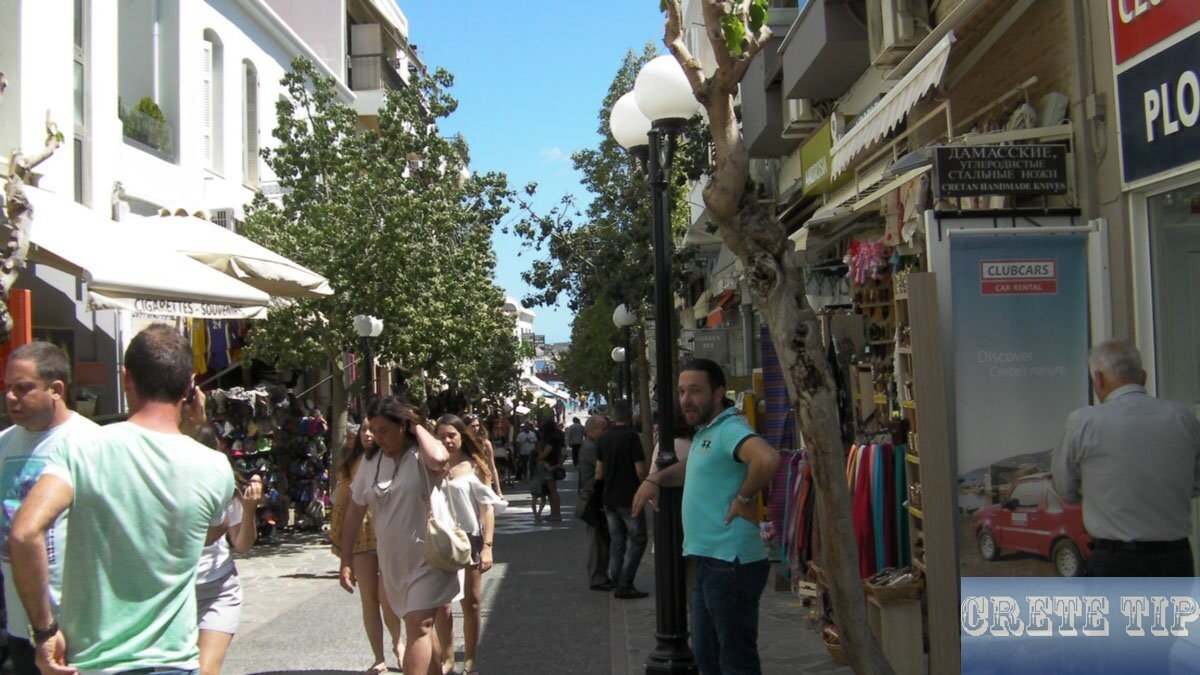Water temperatures, climatic data and information about beach holiday in Crete.
The danger in the sea, other bathing instructions and dogs on the beach.
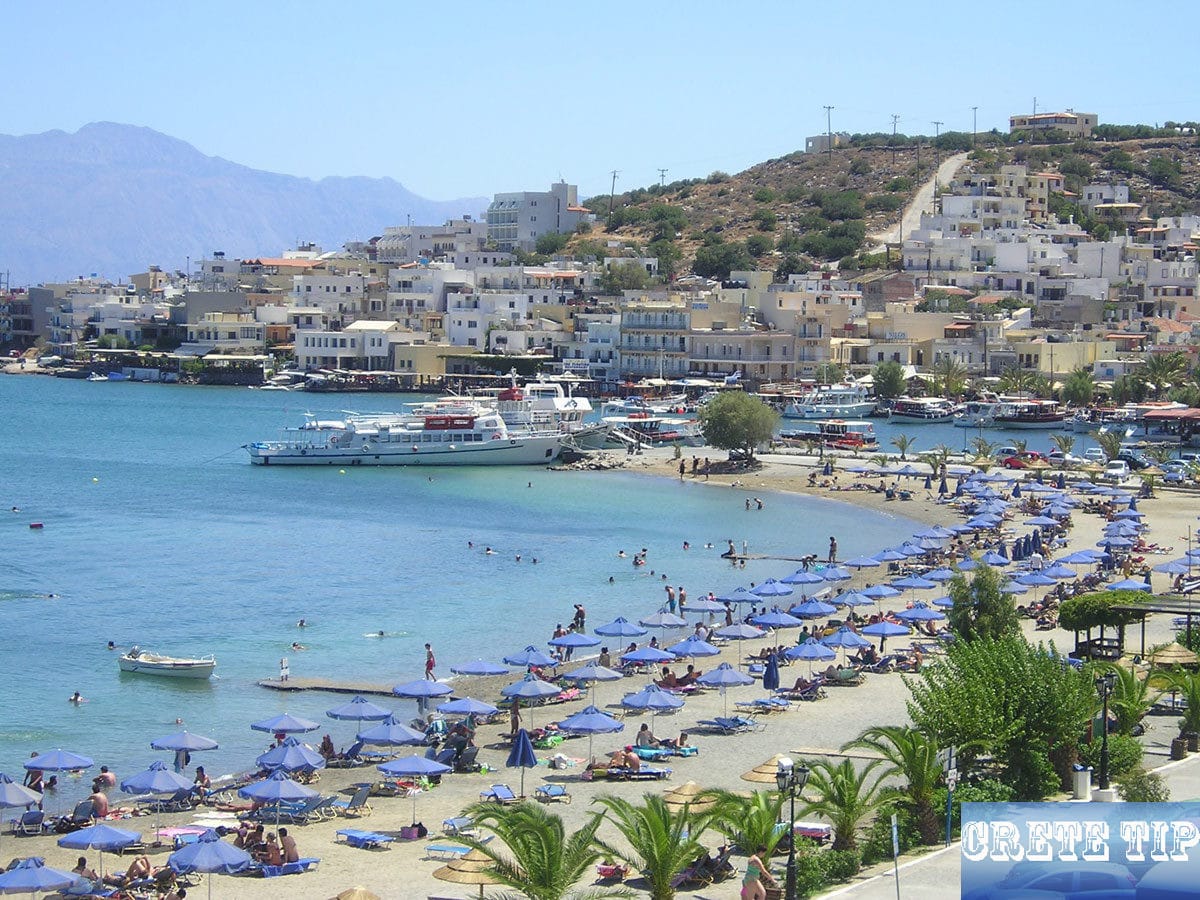
For a beach holiday in Crete it is best to go from June to September. At this time, the sea has a really pleasant bathing temperature of 72 to 75 °F (22°-24 °C), while the temperature of the air is usually between 75 and 86 °F (24-30 °C).
Climates on Crete
Inland, it is very hot during this time, but on the coast there is often a refreshing breeze from the north-west, which makes it difficult for swimming on many days at wind speeds over 9 mph (15 km/h) due to the then high waves. This could happen on many beaches and coats sections of Crete and could also be dangerous for the untrained swimmer.
On the south coast, on the other hand, the north wind blows towards the open sea. This makes the waves not so high, but on the beach itself it can become unpleasant, as occurs, for example, on the long beaches at Ierapetra. This may occur on several days in July and August, when the northwest winds are particularly strong.
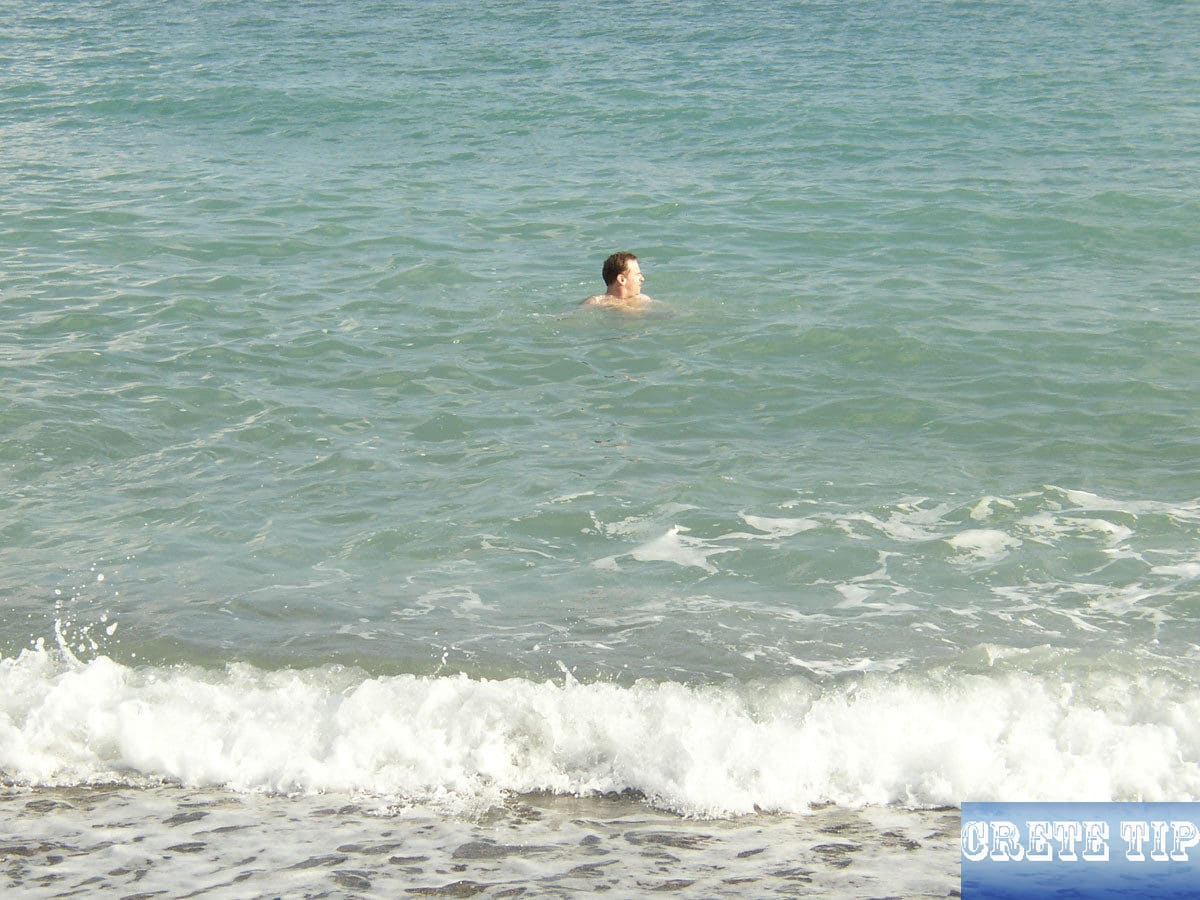
For this reason, it is recommended to stay for a beach holiday close to sheltered bays, e.g. in Elounda.
The beaches along the north coast of Crete are usually flatter and the water is slightly warmer. There are also lifeguards and rescue swimmers on most of the beaches of the north coast. For this, most beaches on the south coast are less visited.
Climatic Data Crete:
Table of Contents
Month | Air (°F/°C) min/max | Water (°F/°C) | Sun hours per day | Rainy days per month |
|---|---|---|---|---|
January | 48-61 (9-16) | 16 | 3 | 12 |
February | 48-61 (9-16) | 15 | 5 | 7 |
March | 50-63 (10-17) | 16 | 6 | 8 |
April | 54-68 (12-20) | 18 | 8 | 4 |
May | 59-73 (15-23) | 19 | 10 | 2 |
June | 66-81 (19-27) | 22 | 12 | 1 |
July | 72-84 (22-29) | 24 | 13 | 0 |
August | 72-84 (22-29) | 25 | 12 | 0 |
September | 66-81 (19-27) | 24 | 10 | 2 |
October | 63-75 (17-24) | 23 | 7 | 6 |
November | 57-70 (14-21) | 20 | 6 | 6 |
December | 52-64 (11-18) | 17 | 4 | 10 |
For the more sensitive swimmer, it is better to wear a swimming suit in April and May as well as from October.
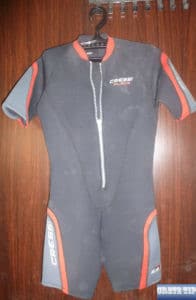
On most public beaches there are sunbathers and sunshades, which can be rented for two people per day for about 6 Euros.
Nevertheless, there is an area on each beach for visitors who have their own beach mats, umbrellas and beach equipment. These are also available everywhere in nearby shops (mini-markets) often cheap to buy. These are usually really ‘cheap-goods’, but for two weeks of bathing holiday it is enough. Of course, most of the locals also bring their own equipment to the beach.

Create your next travel itinerary with the help of AI and the knowledge of thousands of travellers: Use YourTravelItinerary and pick easily the best destinations for your trip. Or generate the itinerary with the automatic assistant within seconds.
Too much heat is dangerous!
Heat waves are the deadliest natural event, even if they are not accompanied by the intensity and ferocity of other phenomena (e.g. floods or storms).
In this context, the METEO Unit of the Athens National Observatory (EAA), in collaboration with the Scientific Committee of the Arsht-Rock Resilience Center of the Atlantic Council, has started the pilot categorisation of days with high temperatures and the issuing of warning levels for the summer period.
There are three warning levels for the main regions and cities of Greece:
Level 3: Extreme temperatures. Significant health risk and highest precautions to be taken.
Level 2: Extremely high temperatures. Danger to health. Take precautionary measures. Prepare to assist persons at risk.
Level 1: Very high temperatures. Follow instructions and do not expose yourself to heat for a long time. Inform people at risk.
Level 0: High temperatures. Health risks for persons at risk.
The regions and warning levels are available via this link.
Flags on the beach

Everyone should know how to behave safely in the surf, sand and sun. The beach and the sea hold many dangers. It’s not just about the big waves, because dangerous currents, lightning, harmful algae, sharks, jellyfish and stings from other creatures lurk in the sea.
For example, rip currents are responsible for 80 per cent of beach rescues and can be dangerous or deadly if you don’t know what to do.
Therefore, if possible, always enter the sea near the lifeguards at organised beaches and know and pay attention to the warning signs. Beach signs give us valuable information about the beach and the surf.
Here is a brief selection of visual signs that can be found on the beaches in Crete.
There are yellow and red buoys in the water. Up to the yellow buoys it is usually safe to stay in the sea, up to the red buoys you swim at your own risk and beyond that you should not swim under any circumstances.
Yellow flag: It means medium danger, because moderate surf and/or currents are present.
Weak swimmers are advised not to enter the water. For others, increased caution and restraint applies.
Red flag: It means increased danger, because there are rough conditions such as strong surf and/or currents.
All swimmers are advised not to enter the water. Those entering the water should exercise great caution.
Double red flags: The water is closed to public use.
Purple flag: Marine pests are present. Jellyfish, stingrays, sea snakes or other sea creatures are in the water and can cause minor injuries.
However, this flag does not indicate the presence of sharks. In this case, the red flag or double red flag should be raised.
Red over yellow flag: This indicates the recommended swimming area with lifeguard supervision.
These flags may be used in pairs, spaced apart, to indicate a specific area or zone along a beach or boardwalk that is most heavily supervised or patrolled by qualified lifeguards and where swimming and/or surfing is permitted.
These flags may be used individually to indicate that swimming is permitted in front of the area where the flag is flown and that the area is supervised by a qualified person.
Quartered Black and White Flag: Area for watercraft. These flags may be used in pairs, spaced apart, to designate a specific area or zone along a beach or boardwalk used by persons with surfboards, jet skis and other watercraft. Boat lanes can also be marked with this flag, but in Crete red buoys/flags are mostly used for this area.
Green flag: The green flag (like the one of the lifeguard tower in the photo above) has no official meaning. It is usually used to indicate that the water may appear calm and inviting for a swim, but it should never be relied upon. Look for a lifeguard or one of the other flags at such beaches for safety and don’t let your children in the water unsupervised!
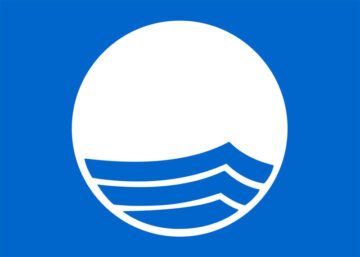
The award of the Environmental Education Foundation stands for sustainable tourism and good water quality.
Danger in the sea
Most swimming accidents happen to untrained swimmers who underestimate winds and waves or overestimate themselves.
So you should not swim with hurried ‘red flags’ above the beach master’s observation point and also not ignore the red buoys on the sea in front of the beach. These warning signs are hoisted in heavy waves, and there are sometimes also dangerous flows outside the marked swimming area or boats could catch the swimmer here.
Every year, disregarding these basic rules, serious accidents occur.
On the other hand, the sea-dwellers are the least concerned about the swimmer.
Shark attacks
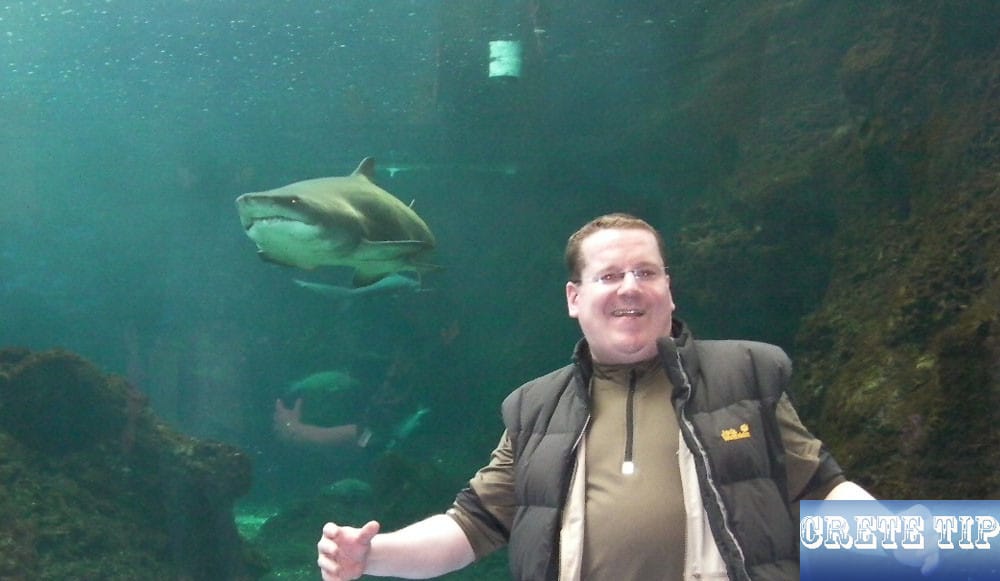
Although there are sharks in the Mediterranean – even the White Shark appears next to 15 other dangerous species – but these do not usually enter the shore zone.
In the last 160 years, there have been only 15 known shark attacks in Greece – and the chance to be killed in a car accident in Greece is about 1,000 times the size of a shark attack.
The majority of the shark attacks in the last 160 years were also not happening to tourists, but mainly divers and fishermen on the open sea, because the dangerous shark species practically never come 100 yards (ca. 91 m) or closer to the coast.
The last known death occurred back in 1956, when a swimmer jumped from his yacht into the sea at Corfu and was attacked by a Great White Shark. This also did not happen in the immediate coast zone.
There is a new study on shark attacks in the waters around Greece between 1847 and 1981.
According to the study, the 1950s was the decade with the most fatal shark attacks in Greek waters. Within these ten years, there were a total of six incidents, five of which were fatal.
The author theorises that the increase in reported incidents in the 1950s ‘may be due to increased reporting and awareness of shark attacks during this period’.
In many of the incidents, the shark species involved in the attack could not be identified. In the cases where identification was possible, most were Great White Sharks (Carcharodon carcharias Linnaeus).
However, overall, shark attacks in Greece are rare. In the 180-year period covered by the study, there were only 15 incidents in total. The profile of shark attack victims in Greece was in line with the global trend: most victims were male and engaged in water sports such as swimming and diving. Ten of the victims were male, four female and three remained unidentified. The relatively young age of the victims may reflect the popularity of these water sports activities among young people.
Most victims were attacked off Corfu, where six incidents were recorded. Two attacks also took place in Attica, while only one incident each was recorded in the Cyclades, Thessaly and the Gulf of Pagasitikos. Some other locations are no longer precisely ascertainable.
No shark attack has occurred in Greece since the last recorded incident in 1981. The low frequency of shark attacks in Greece over the last 180 years suggests that this risk is generally low in Greece.
Nevertheless, there should be continuous monitoring and awareness raising among water sports enthusiasts of potential risks associated with swimming and participation in water activities.
Other sea creatures
For the same reason that you will hardly meet sharks, you will not see dolphins. They also prefer deeper waters and seldom reach the shore.
Even jellyfish are kept away from the shore on Crete and their stitches are painful, but not dangerous for humans. And if you make an acquaintance with a landlord of the shore, like a scorpion fish on a rocky ground or a weaver’s fish on a sandy surface, this is painful but not dangerous if you do not have an allergy.
On the other hand, sea urchins can hurt your feet while you are wading from the shore into the sea. It is therefore advisable to take care where you step and it is generally better to wear bathing or swimming shoes.
Other bathing instructions
Naked bathing or ‘Topless’ is officially forbidden on Crete, but is tolerated on isolated and remote beaches. ‘Topless’ during sunbathing or swimming is tolerated in many tourist centers.
If you come to a beach where other people are naked-bathing or ‘Topless’, it is unlikely that there will be problems.
On beaches, which are mainly visited on the weekends by older locals, you should renounce the naked bathing or ‘Topless’, since this could be regarded as a provocation.
Also remember to take with you sunscreen, sunglasses, hat and drinking water, especially if you want to visit a further offshore beach on the south coast.
In addition, sunscreen, shower gel, toothpaste and similar bath products are much more expensive in Crete – and particularly in tourist shops during the main season – than in UK, so it can be worthwhile to bring along corresponding articles.
Also, alcohol or food is unhealthy and dangerous before bathing, and you should also leave the beach in the condition you found it – please don’t leave any rubbish and other wastes back !
Dogs on the beach
In principle, dogs had the right to come to the beach with their owners. However, with the new Greek animal welfare law 4830/2021 this has changed.
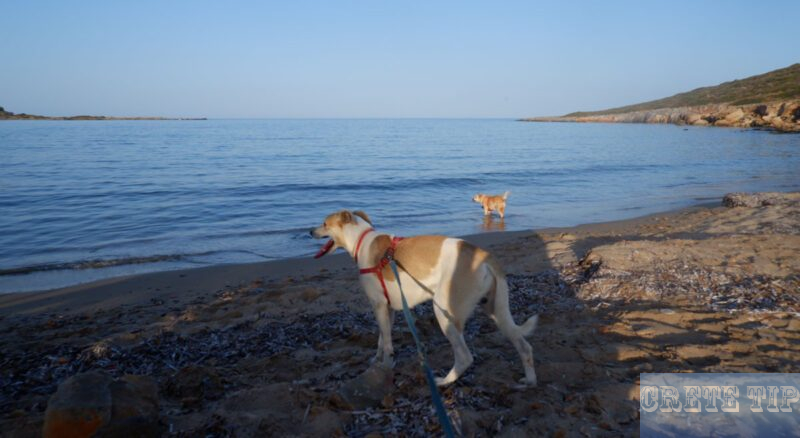
According to it, dogs now only have access to unorganized beaches as well as to the sea. In addition, the use of a leash is obligatory outside the water.
However, it is recommended to carry the dog pet health booklet (ID with the entries of the protective vaccine) if you are asked to submit it. It is also a matter of course that you clean up dog excrement and pay for any damage that your four-legged friend may cause.
On organized beaches, only assistance dogs (e.g. guide dogs) have access or if the legal operator allows it by means of clearly visible signage.
Dog access is generally not allowed on all beaches with a Blue Flag!


